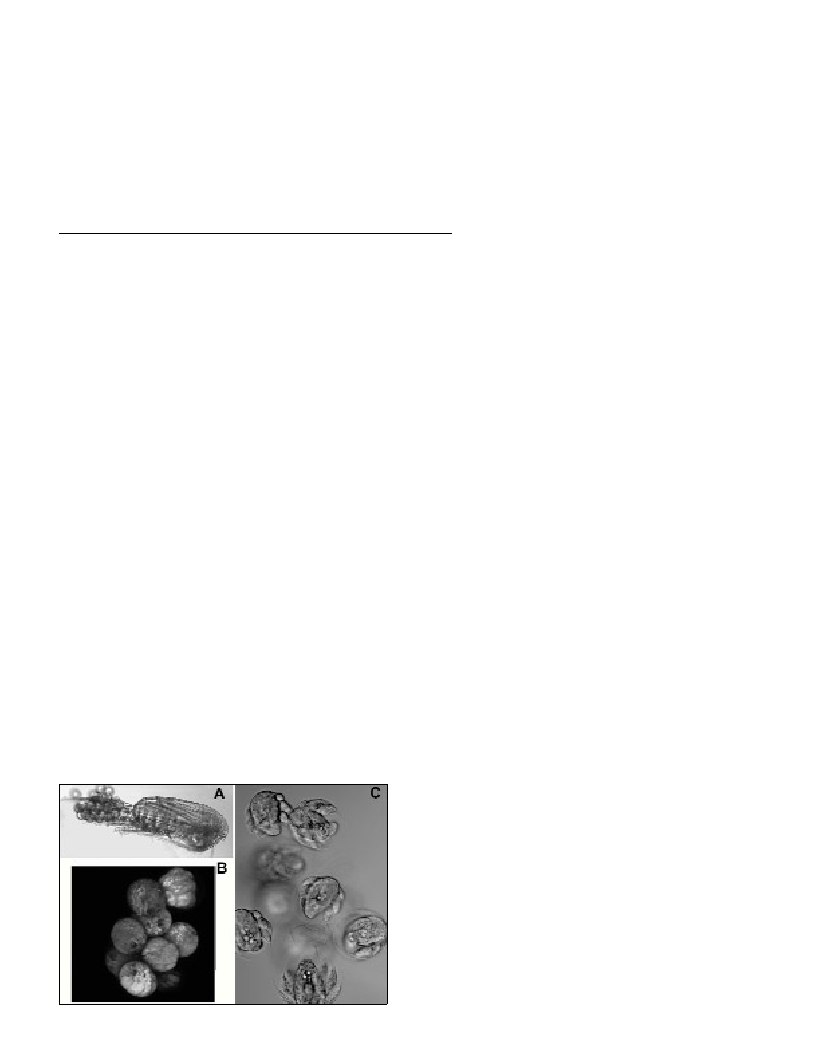A NOVEL METHOD TO DETECT EMBRYO VIABILITY IN THE EGG-CARRYING COPEPOD
CLAUSOCALANUS FURCATUS
Isabella Buttino *, Àurea Peralba and Maria Grazia Mazzocchi
Stazione Zoologica “Anton Dohrn”, Napoli (I), Italy
Abstract
Copepods of the genus Clausocalanusare among the most abundant calanoids in Mediterranean zooplankton communities. However, the
biology of this genus has been scarcely studied due to difficulties in species identification and rearing. Moreover, most Clausocalanus
species carry the eggs, hindering an estimate of their egg production and viability. In fact, when the sac is separated from the female, eggs
are unable to hatch. In this study we apply a novel method to C. furcatus to detect egg viability using vital ?uorescent probe Fluorescein
diacetate (FDA).
Key-words: vital ?uorescent probe; confocal microscopy, ?uorescein diacetate
Rapp. Comm. int. Mer Médit., 37,2004
325
Measurements of hatching success and naupliar viability in
planktonic copepods provide important data for understanding
recruitment rates and secondary production at sea (1). These
parameters have also been used to test diet quality and toxic effects of
marine natural products (2). In broadcast spawner copepods, hatching
success can be easily calculated by allowing eggs to develop
undisturbed to hatching (1). In egg-carrying copepods, however, this
protocol is difficult to apply because embryos are not able to hatch
once isolated from females, and total egg production rates can not be
accurately defined.
In plankton communities over a wide latitudinal range, very
abundant copepods such as Pseudocalanusin the Atlantic Ocean,
Clausocalanusin the Mediterranean Sea, Oithonaand Oncaea in
tropical environments, carry their embryos in sacs or egg masses.
In this study we analysed the egg viability of an egg-carrying
calanoid copepod using a vital ?uorescent probe Fluorescein diacetate
(FDA) (Sigma-Aldrich). This dye penetrates in viable cells where
esterases produce free ?uorescent ?uorescein and cells appear
?uorescent in green.
Our target species was Clausocalanus furcatus(Brady, 1883),
which is dominant in the epipelagic zone above the thermocline
during summer in the Mediterranean Sea (3). Clausocalanus furcatus
carry their eggs on the abdomen in a cylindrical mass that is
discharged when the female is disturbed (4). Our method allowed
analysing egg viability without disturbing females, and provided
accurate measurement of egg production.
Clausocalanus furcatus females were sorted from zooplankton
samples collected in the surface water of the Gulf of Naples (Southern
Italy). They were incubated at 23°C in 2 l jars filled with natural
particle assemblage collected at the sampling site with Niskin bottles.
After 24h, the egg-carrying females were separated in two groups.
One group were incubated in 7.5 µM FDA. After 15 min embryos
were carefully separated from females and observed with the
epi?uorescent or confocal microscopy. The percentage of ?uorescent
embryos is a measure of their viability. Another group of females were
incubated in 300 ml ?ask, left undisturbed until nauplii hatching and
fixed in 4% paraformaldehyde. After settling, nauplii and eggs were
counted under a stereomicroscope, as control.
Figure 1A shows a C. furcatusfemale carrying the egg mass. After
FDA staining, viable embryos appeared ?uorescent in green (Fig. 1B).
The same embryos hatched soon after observation confirming that
they were viable (Fig. 1C). Some nauplii hatched after the embryos
were removed from females probably because they were separated at
the end of the embryonic development. The percentage of ?uorescent
embryos was 99
±
1.5 sd similar to the controls. In free-spawning
copepods this technique required previous permeabilisation of the
chitinouse wall (5)while in egg-carrying copepods this treatment was
not necessary, indicating that eggs lack hard chitin protection in egg-
carrying species.
This simple and precise method allows to rapidly detect egg
viability in egg-carrying copepods and could also be used to
investigate other physiological aspects of egg production, such as
remating frequency, or how long embryos must be carried for a
successful hatching.
References
1-Ianora A., 1998 Copepod life history traits in subtemperate regions.
J.Marine Syst.,15: 337-349.
2-Miralto A., Guglielmo L., Zagami G., Buttino I., Granata A., Ianora A.,
2003 Inhibition of population growth in the copepods Acartia clausiand
Calanus helgolandicusduring diatom blooms. Mar. Ecol. Prog. Ser.,254:
253-268.
3-Mazzocchi M.G. and Ribera d’Alcalà M. 1995 Recurrent patterns in
zooplankton structure and succession in a variable coastal environment.
ICES Journal Marine Science, 52: 679-691.
4-Mazzocchi M.G. and Paffenhöffer G.A., 1998 First observations on the
biology of Clausocalanusfurcatus(Copepoda, Calanoida). J. Plankton
Res.,20: 331-342.
5-Buttino I., Ianora A., Carotenuto Y., Zupo V. and Miralto A., 2003 Use
of the Confocal Laser Scanning Microscope in studies on the
developmental biology of marine invertebrates. Microsc. Res. Tech.,60:
458-464.

